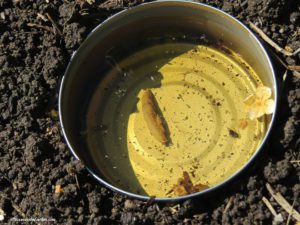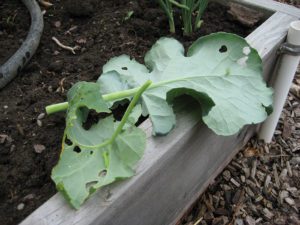Aug. 6 Column: Garden Pests

I thought it would be helpful to write a column on some of the problems that can come up. I’m specifically talking about garden pests that can be very challenging. Here is a link to my column in today’s edition of The Spokesman-Review: Identify the pest before choosing the remedy. (or you can read my column lower in this post)
While I would love to pretend like everything always goes smoothly in my garden, that wouldn’t be honest or realistic! I really can’t complain for the most part because I don’t have a lot of insect problems. But some of them sure are frustrating.
In my column, you’ll learn how I have dealt with them organically. It’s so important we avoid using nasty chemicals. They can have far-reaching implications because many insecticides are non-selective. That means they kill both the bad guys and the good ones.
And now for this week’s video. The topic is growing a winter garden. I know, it’s seems awfully early but this is the best time to get your veggies started. Do you live in an area with cold winters? You might think it’s not possible to grow crops during the fall and winter months. I’m hear to say YES! You can and you should give it a try!
Garden Pests column:
by Susan Mulvihill
Gardening is such a delightful pastime that rewards us with fresh produce and beautiful flowers. When occasional problems crop up, they can dampen our enthusiasm.
My garden has been growing well but that doesn’t mean there haven’t been a few hiccups along the way.
Blister Beetles:
Two months ago, I started noticing small black beetles on a few of my calendula blossoms. I mostly ignored them but started to get irritated when I discovered they love to dine on the flower heads. While researching them, I learned they are blister beetles. The name comes from the caustic substance they secrete. It’s dangerous to animals that inadvertently eat them and causes welts and blisters on human skin.
Since I avoid using chemicals, I took a container of soapy water out to the flower bed. Then I proceeded to tap the beetles, one by one, into the water. Sixty beetles later, I now have a nearly-pristine calendula patch. I’m tickled it was so easy to deal with them.
Slugs:
This spring, my broccoli bed was besieged by hungry slugs. Oh, how I despise those slimy critters. Their calling cards are trails of slime and large holes in the leaves. Green cabbage worms also cause holes. Since I keep my plants covered with fine netting, I knew cabbage butterflies couldn’t lay eggs on the leaves.
How does one deal with slugs? Organic slug bait is one option. I’ve also found that trimming the lowest leaves of the plants that touch the ground is helpful. That eliminates a slug’s preferred method for climbing up into a plant. Another option is to sink an empty cat food or tuna can into the soil. Make sure the top lip is even with the soil surface and partially fill it with beer. The yeast attracts the slugs, they fall in and drown.
Pillbugs
Pillbugs were another challenge for me early in the season. These generally-benign crustaceans think the tender stems of young seedlings such as melons, squash, cucumbers and broccoli are delicious. I sprinkled diatomaceous earth around the base of each seedling to create a barrier until the seedlings’ stems toughened up.
Diatomaceous earth is a powdered substance made from the fossilized remains of algae. The tiny sharp edges cut the skin of certain insects, causing them to dehydrate and die. It is an organic product available at garden centers. I recently learned there are two brands imported from British Columbia. They are Last Crawl Insecticidal DE and APL Diatomaceous Earth. They have been banned by the EPA for being contaminated with trace amounts of dioxins. Other brands are considered safe.
There’s still a mystery pest dining on the foliage in one of my potato beds. I initially suspected Colorado potato beetle larvae but have never seen orange eggs on the leaves’ undersides. There aren’t any larvae or adult beetles for that matter. I thought it might be slugs but there’s no sign of them either.
No matter what type of insect is causing trouble in your garden, it’s crucial to identify the culprit. Then you can decide on a management strategy. Sometimes it’s obvious which insect you’re dealing with but some insects are only active at night. I’ve been known to go out to my garden with a flashlight. I’m looking to see if I can spot any nefarious activities. If you need help identifying an insect there are two helpful services. Contact the Spokane County Master Gardeners at (509) 477-2181 or in Kootenai County at (208) 446-1680.


